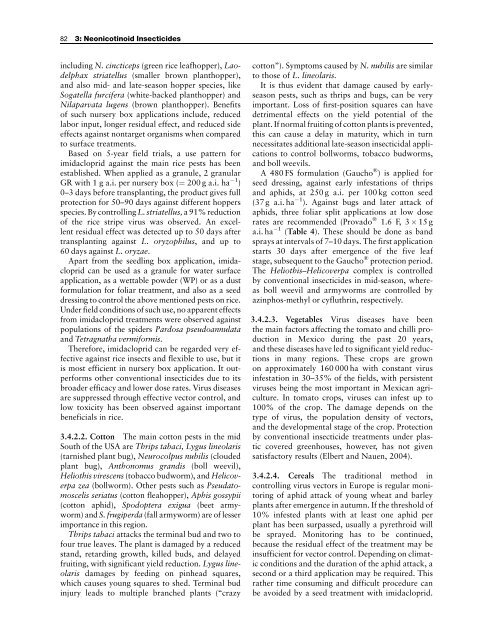Insect Control: Biological and Synthetic Agents - Index of
Insect Control: Biological and Synthetic Agents - Index of
Insect Control: Biological and Synthetic Agents - Index of
Create successful ePaper yourself
Turn your PDF publications into a flip-book with our unique Google optimized e-Paper software.
82 3: Neonicotinoid <strong>Insect</strong>icides<br />
including N. cincticeps (green rice leafhopper), Laodelphax<br />
striatellus (smaller brown planthopper),<br />
<strong>and</strong> also mid- <strong>and</strong> late-season hopper species, like<br />
Sogatella furcifera (white-backed planthopper) <strong>and</strong><br />
Nilaparvata lugens (brown planthopper). Benefits<br />
<strong>of</strong> such nursery box applications include, reduced<br />
labor input, longer residual effect, <strong>and</strong> reduced side<br />
effects against nontarget organisms when compared<br />
to surface treatments.<br />
Based on 5-year field trials, a use pattern for<br />
imidacloprid against the main rice pests has been<br />
established. When applied as a granule, 2 granular<br />
GR with 1 g a.i. per nursery box (¼ 200 g a.i. ha 1 )<br />
0–3 days before transplanting, the product gives full<br />
protection for 50–90 days against different hoppers<br />
species. By controlling L. striatellus, a 91% reduction<br />
<strong>of</strong> the rice stripe virus was observed. An excellent<br />
residual effect was detected up to 50 days after<br />
transplanting against L. oryzophilus, <strong>and</strong> up to<br />
60 days against L. oryzae.<br />
Apart from the seedling box application, imidacloprid<br />
can be used as a granule for water surface<br />
application, as a wettable powder (WP) or as a dust<br />
formulation for foliar treatment, <strong>and</strong> also as a seed<br />
dressing to control the above mentioned pests on rice.<br />
Under field conditions <strong>of</strong> such use, no apparent effects<br />
from imidacloprid treatments were observed against<br />
populations <strong>of</strong> the spiders Pardosa pseudoannulata<br />
<strong>and</strong> Tetragnatha vermiformis.<br />
Therefore, imidacloprid can be regarded very effective<br />
against rice insects <strong>and</strong> flexible to use, but it<br />
is most efficient in nursery box application. It outperforms<br />
other conventional insecticides due to its<br />
broader efficacy <strong>and</strong> lower dose rates. Virus diseases<br />
are suppressed through effective vector control, <strong>and</strong><br />
low toxicity has been observed against important<br />
beneficials in rice.<br />
3.4.2.2. Cotton The main cotton pests in the mid<br />
South <strong>of</strong> the USA are Thrips tabaci, Lygus lineolaris<br />
(tarnished plant bug), Neurocolpus nubilis (clouded<br />
plant bug), Anthonomus gr<strong>and</strong>is (boll weevil),<br />
Heliothis virescens (tobacco budworm), <strong>and</strong> Helicoverpa<br />
zea (bollworm). Other pests such as Pseudatomoscelis<br />
seriatus (cotton fleahopper), Aphis gossypii<br />
(cotton aphid), Spodoptera exigua (beet armyworm)<br />
<strong>and</strong> S. frugiperda (fall armyworm) are <strong>of</strong> lesser<br />
importance in this region.<br />
Thrips tabaci attacks the terminal bud <strong>and</strong> two to<br />
four true leaves. The plant is damaged by a reduced<br />
st<strong>and</strong>, retarding growth, killed buds, <strong>and</strong> delayed<br />
fruiting, with significant yield reduction. Lygus lineolaris<br />
damages by feeding on pinhead squares,<br />
which causes young squares to shed. Terminal bud<br />
injury leads to multiple branched plants (‘‘crazy<br />
cotton’’). Symptoms caused by N. nubilis are similar<br />
to those <strong>of</strong> L. lineolaris.<br />
It is thus evident that damage caused by earlyseason<br />
pests, such as thrips <strong>and</strong> bugs, can be very<br />
important. Loss <strong>of</strong> first-position squares can have<br />
detrimental effects on the yield potential <strong>of</strong> the<br />
plant. If normal fruiting <strong>of</strong> cotton plants is prevented,<br />
this can cause a delay in maturity, which in turn<br />
necessitates additional late-season insecticidal applications<br />
to control bollworms, tobacco budworms,<br />
<strong>and</strong> boll weevils.<br />
A 480 FS formulation (Gaucho Õ ) is applied for<br />
seed dressing, against early infestations <strong>of</strong> thrips<br />
<strong>and</strong> aphids, at 250 g a.i. per 100 kg cotton seed<br />
(37 g a.i. ha 1 ). Against bugs <strong>and</strong> later attack <strong>of</strong><br />
aphids, three foliar split applications at low dose<br />
rates are recommended (Provado Õ 1.6 F, 3 15 g<br />
a.i. ha 1 (Table 4). These should be done as b<strong>and</strong><br />
sprays at intervals <strong>of</strong> 7–10 days. The first application<br />
starts 30 days after emergence <strong>of</strong> the five leaf<br />
stage, subsequent to the Gaucho Õ protection period.<br />
The Heliothis–Helicoverpa complex is controlled<br />
by conventional insecticides in mid-season, whereas<br />
boll weevil <strong>and</strong> armyworms are controlled by<br />
azinphos-methyl or cyfluthrin, respectively.<br />
3.4.2.3. Vegetables Virus diseases have been<br />
the main factors affecting the tomato <strong>and</strong> chilli production<br />
in Mexico during the past 20 years,<br />
<strong>and</strong> these diseases have led to significant yield reductions<br />
in many regions. These crops are grown<br />
on approximately 160 000 ha with constant virus<br />
infestation in 30–35% <strong>of</strong> the fields, with persistent<br />
viruses being the most important in Mexican agriculture.<br />
In tomato crops, viruses can infest up to<br />
100% <strong>of</strong> the crop. The damage depends on the<br />
type <strong>of</strong> virus, the population density <strong>of</strong> vectors,<br />
<strong>and</strong> the developmental stage <strong>of</strong> the crop. Protection<br />
by conventional insecticide treatments under plastic<br />
covered greenhouses, however, has not given<br />
satisfactory results (Elbert <strong>and</strong> Nauen, 2004).<br />
3.4.2.4. Cereals The traditional method in<br />
controlling virus vectors in Europe is regular monitoring<br />
<strong>of</strong> aphid attack <strong>of</strong> young wheat <strong>and</strong> barley<br />
plants after emergence in autumn. If the threshold <strong>of</strong><br />
10% infested plants with at least one aphid per<br />
plant has been surpassed, usually a pyrethroid will<br />
be sprayed. Monitoring has to be continued,<br />
because the residual effect <strong>of</strong> the treatment may be<br />
insufficient for vector control. Depending on climatic<br />
conditions <strong>and</strong> the duration <strong>of</strong> the aphid attack, a<br />
second or a third application may be required. This<br />
rather time consuming <strong>and</strong> difficult procedure can<br />
be avoided by a seed treatment with imidacloprid.










